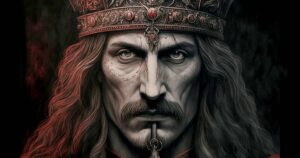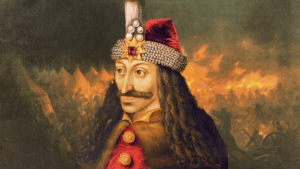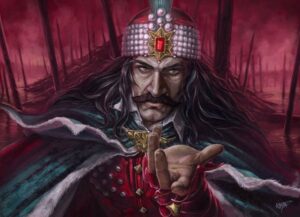In the annals of history, few figures are as enigmatic and shrouded in darkness as Vlad the Impaler.
This medieval ruler, known for his brutal tactics and ruthless demeanour, left an indelible mark on the pages of history.
In this exploration, we delve into the life and legacy of Vlad the Impaler, seeking to unravel the portrait of a figure whose name still evokes both fascination and horror.
The Historical Context – Vlad The Impaler: Reign in 15th Century Wallachia

Vlad the Impaler
Rise to Power – The Son of the Dragon
Vlad III, commonly known as Vlad the Impaler, was born in the 15th century into the House of Drăculești, a noble family with ties to the Order of the Dragon. His father, Vlad II, was inducted into the Order, leading to Vlad III being referred to as “Son of the Dragon” or Dracula. The tumultuous political landscape of Wallachia, part of modern-day Romania, set the stage for Vlad’s ascent to power.
The Ottoman Threat – Vlad’s Ruthless Tactics
Vlad’s reign was marked by constant conflict with the Ottoman Empire. Faced with the threat of invasion, he employed ruthless strategies to defend Wallachia. His infamous method of impaling enemies on long, sharp stakes earned him the moniker “Vlad the Impaler.” Though brutal, his tactics were a response to the merciless nature of the Ottoman forces and aimed at instilling fear among potential adversaries.
Vlad the Impaler: The Citadel of Poenari – Vlad’s Fortress of Power
As ruler of Wallachia, Vlad the Impaler sought to fortify his realm against external threats. The Citadel of Poenari, perched on a mountain peak, became a symbol of his defiance against the Ottoman Empire. Vlad’s strategic use of this fortress reflected his determination to withstand sieges and protect his territory at any cost.
Vlad the Impaler: The Dracula Mythos – Legends and Realities

Vlad the Impaler Perspectives
Literary Influence – Dracula in Fictional Realms
Vlad the Impaler’s legacy extends beyond the historical realm into literature, most notably through Bram Stoker’s iconic novel, “Dracula.” Stoker’s fictional Count Dracula drew inspiration from the historical figure, blending facts with imaginative elements. The novel, published in 1897, catapulted Vlad into the realm of Gothic horror, forever intertwining his name with the vampire mythos.
Vlad’s Reputation – A Complex Legacy
Vlad the Impaler’s reputation is a complex tapestry of historical facts and embellished legends. While his brutal methods are well-documented, some accounts suggest that the extent of his cruelty may have been exaggerated over time. The dichotomy between the ruthless ruler and the defender of Wallachia against the Ottoman threat adds layers of intrigue to Vlad’s legacy.
Vlad the Impaler: Cultural Impact – Dracula in Popular Culture
The Dracula mythos has permeated popular culture through numerous adaptations in literature, film, and other media. From Bela Lugosi’s iconic portrayal in the 1931 film to modern interpretations like Francis Ford Coppola’s “Bram Stoker’s Dracula,” Vlad the Impaler’s influence echoes through the centuries, capturing the imagination of audiences worldwide.
Vlad’s Enduring Legacy – Historical Reflections

Vlad the Impaler Dracula
Controversial Figure – Perspectives on Vlad’s Rule
Vlad the Impaler remains a controversial figure, sparking debates among historians and scholars. While some view him as a patriot defending his realm from external threats, others condemn his ruthless methods, questioning the ethics of his rule. The nuanced examination of Vlad’s reign requires a careful balance between historical analysis and the context of the time.
Vlad the Impaler: Tourist Attraction – Visiting Vlad’s Realms Today
The legacy of Vlad the Impaler has become a tourist attraction in modern Romania. The region of Transylvania, associated with the Dracula mythos, draws visitors eager to explore the historical sites connected to Vlad’s rule. Bran Castle, often referred to as “Dracula’s Castle,” has become a popular destination, inviting travelers to step into the realm where history and legend converge.
Lessons from History – Vlad’s Impact on Wallachia
While Vlad the Impaler’s methods may be seen as extreme, his determination to protect Wallachia from external threats cannot be denied. The lessons from his reign highlight the complexities of leadership during turbulent times, sparking discussions on the ethical boundaries of defending one’s homeland.
Vlad the Impaler Conclusion: A Complex Portrait of Power and Horror
Vlad the Impaler, a figure whose name elicits both fascination and dread, represents a complex interplay of historical realities and fictional embellishments.
His ruthless tactics and indomitable spirit in the face of external threats have left an enduring mark on the pages of history.
As we unravel the layers of Vlad’s legacy, we confront the intricacies of power, survival, and the indelible impact one individual can have on the course of history.











